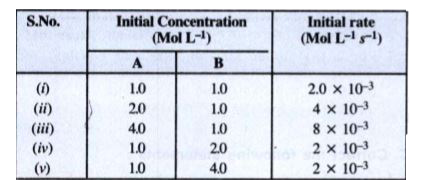Consider this reaction: A+B→C+D+ energy
this reaction is exergonic
an enzyme could still speed the reaction
A and B are reactants, C and D are products
all of the above are correct
The correct Answer is:D
To solve the question regarding the reaction A+B→C+D+energy, we will analyze each statement provided in the options and determine their validity.
1. Understanding the Reaction Type:
- The reaction A+B→C+D+energy indicates that energy is released during the reaction. This suggests that the reaction is exergonic, meaning it occurs spontaneously and releases free energy.
Hint: Look for keywords like "releases energy" to identify exergonic reactions.
2. Analyzing the Role of Enzymes:
- The statement mentions that an enzyme could still speed the reaction. Enzymes are biological catalysts that lower the activation energy required for a reaction to proceed. They do not change the overall free energy of the reactants and products but can increase the rate at which equilibrium is reached.
Hint: Remember that enzymes affect the rate of reaction, not the energy levels of reactants or products.
3. Identifying Reactants and Products:
- The question states that A and B are the reactants, while C and D are the products. This is consistent with the general format of a chemical reaction where reactants are transformed into products.
Hint: In a chemical equation, the substances on the left side of the arrow are reactants, and those on the right side are products.
4. Conclusion:
- Since all three statements are correct:
- The reaction is exergonic.
- An enzyme could speed up the reaction.
- A and B are reactants, and C and D are products.
- Therefore, the correct answer is that all of the above are correct.
Final Answer:
The correct option is all of the above are correct.
---
- The reaction A+B→C+D+energy indicates that energy is released during the reaction. This suggests that the reaction is exergonic, meaning it occurs spontaneously and releases free energy.
- The statement mentions that an enzyme could still speed the reaction. Enzymes are biological catalysts that lower the activation energy required for a reaction to proceed. They do not change the overall free energy of the reactants and products but can increase the rate at which equilibrium is reached.
- The question states that A and B are the reactants, while C and D are the products. This is consistent with the general format of a chemical reaction where reactants are transformed into products.
- Since all three statements are correct:
- The reaction is exergonic.
- An enzyme could speed up the reaction.
- A and B are reactants, and C and D are products.
- Therefore, the correct answer is that all of the above are correct.
The correct option is all of the above are correct.
Topper's Solved these Questions
- BIOMOLECULESBOOK - ICSECHAPTER - BIOMOLECULESEXERCISE - TEST YOUR PROGRESS (FILL IN THE BLANKS WITH APPROPRIATE WORDS.)
59 Videos
- BIOMOLECULESBOOK - ICSECHAPTER - BIOMOLECULESEXERCISE - TEST YOUR PROGRESS (STATE WHETHER THE FOLLOWING STATEMENTS ARE TRUE OF FALSE.)
27 Videos
- BIOLOGY ISC SAMPLE QUESTION PAPER 2019BOOK - ICSECHAPTER - BIOLOGY ISC SAMPLE QUESTION PAPER 2019EXERCISE - PART-II (SECTION -C)
6 Videos
- BODY FLUIDS AND CIRCULATIONBOOK - ICSECHAPTER - BODY FLUIDS AND CIRCULATIONEXERCISE - DIFFRENTIATE BETWEEN
13 Videos
Similar Questions
Consider the reaction,
2A+B→C+D , If the rate expression is r=K[A]2[B]1 and if volume is reduced to 13 , the rate of reaction will increase by
View SolutionFor the reaction
2A+B→C

Find X & Y.
View SolutionFor the reaction : A+2B→C+D, the expression of rate of reaction will be :
View SolutionConsider the reaction, A+B→C+D.
The initial rate for different initial concentrations of the reactants are given below :

Suggest a possible mechanism.
View SolutionConsider the reaction, A+B→C+D.
The initial rate for different initial concentrations of the reactants are given below :

What is the overall order ?
View SolutionConsider the reaction, A+B→C+D.
The initial rate for different initial concentrations of the reactants are given below :

What is the overall order ?
View SolutionConsider the reaction, A+B→C+D.
The initial rate for different initial concentrations of the reactants are given below :

Suggest a possible mechanism.
View SolutionConsider the reaction, A+B→C+D.
The initial rate for different initial concentrations of the reactants are given below :

Calculate the rate constant.
View SolutionConsider the reaction, A+B→C+D.
The initial rate for different initial concentrations of the reactants are given below :

What is the overall order ?
View SolutionConsider the reaction, A+B→C+D.
The initial rate for different initial concentrations of the reactants are given below :

Suggest a possible mechanism.
View Solution
